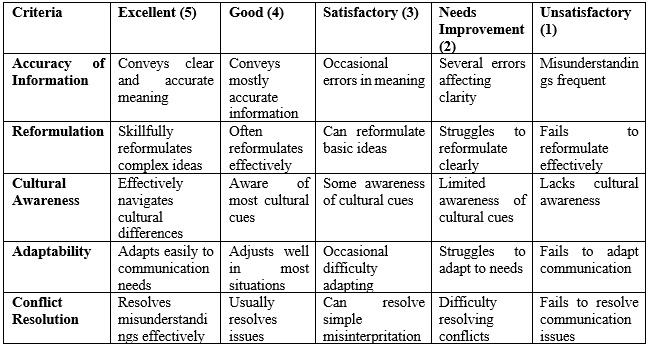Considering the global and multilingual nature of the maritime industry, incorporating mediation strategies into Maritime English instruction is crucial for promoting effective communication among seafarers. This is particularly important due to the necessity of ensuring clear and accurate communication to maintain safety and efficiency in navigation.
One day, aboard a cargo vessel navigating through congested waters, the crew – each speaking a different language – faces a sudden navigational emergency. A storm starts, and immediate action is required. But how do they ensure instructions are understood clearly across language barriers? This is where the role of mediation in teaching Maritime English comes into play.
Imagine mediation as a bridge connecting two shores: one representing seafarers with limited English proficiency, and the other, the technical demands of maritime operations. The bridge allows for the flow of not simply words, but understanding.
Mediation, in a broader sense, can be seen as the art of facilitating communication and understanding between individuals or groups. It serves as an intermediary, a translator of both language and meaning, especially when people come from different linguistic or cultural backgrounds. It’s not about expressing personal thoughts but ensuring clear, accurate communication between interlocutors.
When it comes to teaching languages, particularly in specialized areas like Maritime English, mediation is essential. The Common European Framework of Reference for Languages (CEFR), a comprehensive guide for language teaching, initially introduced mediation as a process where the language user acts not for self-expression, but as a communicator between parties unable to directly understand each other – often due to language differences. Think of a situation on deck where a chief engineer, who speaks little English, needs to explain a complex engine malfunction to a multinational crew. Mediation becomes the invisible force in that case.
Today, teachers have the opportunity exists to implement mediation strategies in Maritime English instruction, thus, raising the level of teaching. This can be done through role-playing scenarios, where students practice translating critical maritime procedures between languages, or by creating simulations that require collaborative problem-solving. These techniques ensure that future seafarers are not just proficient in English, but also capable of bridging communication gaps, ensuring safer and more efficient navigation in international waters.
The teachers of the Department of Languages, State University of Infrastructure and Technologies, successfully integrate mediation strategies into their classes, but we still have some difficulties. The paper aims to analyse challenges we meet.
During their shipboard training and further work our students will cooperate with seafarers from a wide range of countries and linguistic backgrounds, making it difficult to find common ground. This diversity adds complexity to mediation, as cultural norms, values, and communication styles vary significantly. To solve the issue a subject “Leadership and Bridge Resource Management” (language of instruction – English) has been included in curriculum. It familiarizes students with cultural differences and challenges they can meet onboard and provides deep cultural understanding.
Maritime English involves highly technical terminology related to navigation, ship operations, and safety protocols. Mediation in this context is not just about translating common phrases but also about ensuring accurate comprehension of complex and often life-critical instructions. Misunderstanding or misinterpreting technical terms can lead to severe safety risks. We must be able to mediate between students’ limited English skills and the precise technical requirements of the industry, which can be a difficult balancing act.
While there is an increasing recognition of the importance of mediation in language teaching, there is still a lack of dedicated resources, teaching materials, and training programs in maritime context. Teachers of our department design the tasks on their own, which is not always simple, but we analyse students’ experience, resources for teaching mediation in general and transform into maritime context.
Assessment of mediation skills communication is complex. Researchers develop frameworks and tools to assess the effectiveness of mediation strategies.
Mediation skills are often context-dependent. A student may mediate well in one scenario but struggle in another. Developing diverse assessment tasks helps capture a broader range of skills.
While mediation is important, learners also need to develop autonomy in communication. Research explores how to balance teacher mediation with encouraging independent communication skills.
A well-designed rubric helps assess mediation skills by outlining clear criteria and performance levels. Below is an example of key components in a rubric:
With the growing use of digital tools and automated systems in the maritime industry, seafarers must now communicate not only with each other but also with technology (e.g., navigation systems, automated reporting tools). Mediation in this context involves not just human-to-human communication but also interpreting and understanding equipment-generated data. The challenge for educators is to teach mediation skills that extend beyond language, incorporating the interpretation of technical data into human interactions.
In conclusion, while mediation offers significant benefits for enhancing communication in Maritime English, it comes with a set of challenges that educators must address. These include cultural and linguistic diversity, technical jargon, high-pressure environments, and the integration of mediation into standardized communication practices. Overcoming these problems requires targeted resources, innovative teaching approaches, and a focus on both linguistic and intercultural competence.
References:
1. Common European Framework of Reference for Languages: Learning, Teaching, Assessment (CEFR) - Common European Framework of Reference for Languages (CEFR) - www.coe.int. Common European Framework of Reference for Languages (CEFR). URL: https://www.coe.int/en/web/common-european-framework-reference-languages/home (date of access: 18.10.2024).
2. Farrell T., Alani H., Mikroyannidis A. Mediating learning with learning analytics technology: guidelines for practice. Teaching in Higher Education. 2022. P. 1–21. URL: https://doi.org/10.1080/13562517.2022.2067745 (date of access: 18.10.2024).
3. Learning processes and their mediating role between teaching quality and student achievement: A systematic review / A. Alp Christ et al. Studies in Educational Evaluation. 2022. Vol. 75. P. 101209. URL: https://doi.org/10.1016/j.stueduc.2022.101209 (date of access: 18.10.2024).
4. MEDIATION: What it is, how to teach it and how to assess it. Cambridge : Cambridge University Press, 2022. 20 p. URL: https://www.cambridgeenglish.org/Images/664965-mediation-what-it-is-how-to-teach-it-and-how-to-assess-it.pdf (date of access: 18.10.2024).
|








